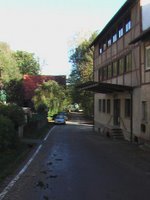 The second part of my entirely made up history of the Körschtalbahn. I suggest you start with the first part, here. Almost all the events in this story have happened on narrow or standard gauge railways in our region. I’ve just pushed them all together…
The second part of my entirely made up history of the Körschtalbahn. I suggest you start with the first part, here. Almost all the events in this story have happened on narrow or standard gauge railways in our region. I’ve just pushed them all together…From the first ten years the line grew and the traffic forecasts were fulfilled, even exceeded by traffic returns. Several wood mills worked in the valley, and a steel works began production in Körschbrunnen. A mallet supplemented the two 0-6-0 tank engines in 1904. A second, heavier unit followed two years later. Together these powered up and down the Körschtal with their heavy wood trains.
However, there was now a problem. Coal costs money, and transporting the stuff cost more money. The directors had long been looking at the fast-flowing river Körsch and imagining the potential for cheap electricity. The more visionary ones were already drawing up cost/benefit analyses. In 1913 the decision was made to electrify the line, and the Körschtalbahn placed an order with the Esslingen Maschinenfabrik near Stuttgart for two electric c-c railcars.
In 1914 Electric power was switched on from Wildberg to Dachsburg. Originally it is clear that the directors wanted to have wires beyond the station at Dachsburg and up the final section to Spitzenwald, but the First World War intervened and steam remained on the upper section. The steam locomotives also continued to run on the lower Körschtal for freights that the railcars couldn’t handle. This did not stop the Government requisitioning first one and then both of the 0-6-0 tank engines for use on the Russian front, where they both disappeared. By the end of the war, the manpower difficulties had reduced the steam fleet to one Mallet, and the railcars were struggling with the increased traffic.
The chaos between the wars allowed for little investment, although two steeple cab locomotives were purchased second hand from a line in north Germany. As with all of the rest of Germany’s railways the Körschtalbahn came under national control in the 1930’s and for the next ten to fifteen years the story was one of overuse and under investment. Stone and wood were moved in huge quantities, so much so that two diesels were brought in to assist.
The Second World War would make depressing reading, so I’ll stick to saying that after the war the line was worn out. One Mallet was still operable and ran the whole length of the line when there were power failures, which were frequent. As the “Economic miracle” began to take place, and the industries grew in the Lower and Upper Körschtal, the line built up traffic, but it urgently needed new investment, new trains, and a complete overhaul of the infrastructure.
Continued on part 3.
No comments:
Post a Comment